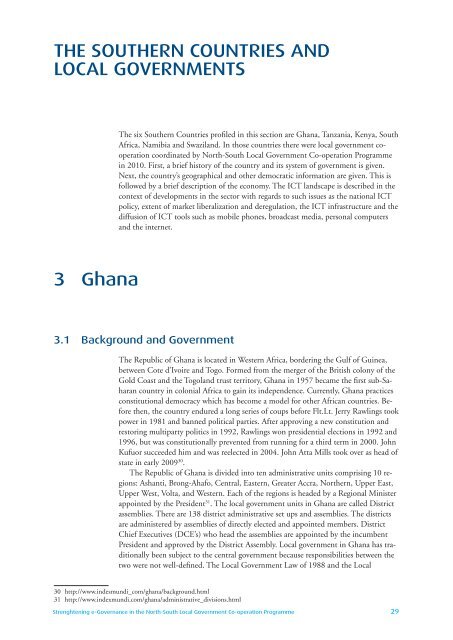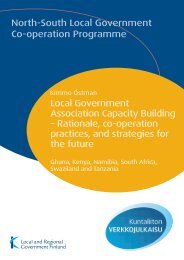E-READINESS QUESTIONNAIRE FOR NORTH ... - Kunnat.net
E-READINESS QUESTIONNAIRE FOR NORTH ... - Kunnat.net
E-READINESS QUESTIONNAIRE FOR NORTH ... - Kunnat.net
Create successful ePaper yourself
Turn your PDF publications into a flip-book with our unique Google optimized e-Paper software.
THE SOUTHERN COUNTRIES AND<br />
LOCAL GOVERNMENTS<br />
3 Ghana<br />
The six Southern Countries profi led in this section are Ghana, Tanzania, Kenya, South<br />
Africa, Namibia and Swaziland. In those countries there were local government cooperation<br />
coordinated by North-South Local Government Co-operation Programme<br />
in 2010. First, a brief history of the country and its system of government is given.<br />
Next, the country’s geographical and other democratic information are given. This is<br />
followed by a brief description of the economy. The ICT landscape is described in the<br />
context of developments in the sector with regards to such issues as the national ICT<br />
policy, extent of market liberalization and deregulation, the ICT infrastructure and the<br />
diffusion of ICT tools such as mobile phones, broadcast media, personal computers<br />
and the inter<strong>net</strong>.<br />
3.1 Background and Government<br />
The Republic of Ghana is located in Western Africa, bordering the Gulf of Guinea,<br />
between Cote d’Ivoire and Togo. Formed from the merger of the British colony of the<br />
Gold Coast and the Togoland trust territory, Ghana in 1957 became the fi rst sub-Saharan<br />
country in colonial Africa to gain its independence. Currently, Ghana practices<br />
constitutional democracy which has become a model for other African countries. Before<br />
then, the country endured a long series of coups before Flt.Lt. Jerry Rawlings took<br />
power in 1981 and banned political parties. After approving a new constitution and<br />
restoring multiparty politics in 1992, Rawlings won presidential elections in 1992 and<br />
1996, but was constitutionally prevented from running for a third term in 2000. John<br />
Kufuor succeeded him and was reelected in 2004. John Atta Mills took over as head of<br />
state in early 2009 30 .<br />
The Republic of Ghana is divided into ten administrative units comprising 10 regions:<br />
Ashanti, Brong-Ahafo, Central, Eastern, Greater Accra, Northern, Upper East,<br />
Upper West, Volta, and Western. Each of the regions is headed by a Regional Minister<br />
appointed by the President 31 . The local government units in Ghana are called District<br />
assemblies. There are 138 district administrative set ups and assemblies. The districts<br />
are administered by assemblies of directly elected and appointed members. District<br />
Chief Executives (DCE’s) who head the assemblies are appointed by the incumbent<br />
President and approved by the District Assembly. Local government in Ghana has traditionally<br />
been subject to the central government because responsibilities between the<br />
two were not well-defi ned. The Local Government Law of 1988 and the Local<br />
30 http://www.indesmundi_com/ghana/background.html<br />
31 http://www.indexmundi.com/ghana/administrative_divisions.html<br />
Strenghtening e-Governance in the North-South Local Government Co-operation Programme 29




